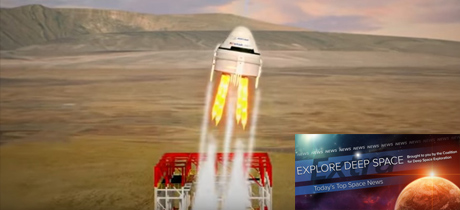In Today’s Deep Space Extra… NASA’s Commercial Crew Program outlines dates for upcoming crucial tests of Boeing’s CST-100 Starliner and SpaceX’s Crew Dragon as they work to establish a new U.S. human launch capability in 2020. Like those of the Apollo era, NASA’s Artemis astronauts will gather samples of the Moon for return to Earth as they resume human lunar exploration in 2024.
Human Space Exploration
Boeing and SpaceX preparing for commercial crew abort tests
Coalition Member in the News – Boeing
SpaceNews.com (10/30): In presentations before the NASA Advisory Council in Washington on Wednesday, NASA Commercial Crew Program manager Kathy Leuters outlined milestone test activities that could determine if Boeing’s CST-100 Starliner and SpaceX’s Crew Dragon are certified to begin the regular scheduled transportation of astronauts to and from the International Space Station (ISS) in early 2020. First up is a launch pad abort test for Boeing on November 4 at the White Sands Missile Test Range in New Mexico.
Artemis missions face sample return crunch
SpaceNews.com (10/30): Mass limits currently appear to restrict how much lunar material the initial NASA Artemis missions intended to return human explorers to the Moon’s surface can bring back to Earth to just 35 kilograms, or about 77 pounds. NASA hopes to increase the limit to 100 kilograms as it develops the capabilities to accelerate a human return to 2024.
Space Science
New telescope instrument will watch the sky with 5,000 eyes
Universe Today (10/30): Dark Energy is estimated to comprise 68 percent of the universe and is held responsible for its expansion. A new observing instrument at the Kitt Peak National Observatory, the Dark Energy Spectroscopic Instrument, is equipped with 5,000 “eyes” to chart the distance between the Earth and millions of galaxies and quasars to assess how dark energy and gravity compete to push and pull the universe’s normal matter.
The first cubesats to Mars were almost lost upon arrival
Space.com (10/30): Remarkably, NASA’s first ever interplanetary mission with smallsats, Mars Cube One, or MarCo A and B, served as a valuable communications relay as the Mars InSight lander touched down on the Red Planet in late November 2018. InSight is exploring the Red Planet’s subsurface activities to characterize the mantle and core as well as the crust. There was drama on the eve of the landing, when MarCo B did not check in with controllers at NASA’s Jet Propulsion Laboratory (JPL). And then on the day of landing, MarCo A went quiet in response to a star tracker navigation issue. MarCo B apparently self-corrected an attitude control issue. Then MarCo A checked in as well before the touchdown. The drama of the MarCo operations was highlighted during a presentation at last week’s International Astronautical Congress (IAC) in Washington D.C.
First Mode joins Arizona State’s team to flesh out a plan for a marathon Moon rover
GeekWire.com (10/28): The partnership is looking to develop a rover, Intrepid, that could cover more than 1,100 miles of the lunar surface over a four year drive that includes more than 100 sites to seek signs of lunar water ice, map the radiation and solar wind environments and assess the chemistry of the lunar soil. The proposed landing site is north of the lunar equator at the Reiner Gamma magnetic anomaly.
NASA green lights study for orbital mission to Pluto
AmericaSpace.com (10/30): NASA’s New Horizons mission teams offered stunning results, including that distant Pluto is geologically active, as its spacecraft carried out the first every flyby of the distant world in July 2015. Now, the mission team at the Southwest Research Institute has received NASA funding to assess the possibility of a future longer term orbital mission to Pluto and its five moons. The study results will be further assessed by the National Academies of Sciences, Engineering and Medicine as it prepares a new study of planetary science priorities.
New Horizons team releases images of Pluto’s far side
Spaceflight Insider (10/30): In July 2015, NASA’s New Horizons spacecraft carried out the first ever close flyby of distant Pluto. Now, the New Horizons science team has released images of Pluto’s far side, all due for publication in the journal Icarus. Among the far side discoveries is evidence of a major near side impact, a collision that produced the impact crater designated Sputnik Planitia.
The cosmological conundrum of the expansion rate of the universe
Space.com (10/30): The universe is expanding, astronomer Edwin Hubble discovered in the 2020’s. However, experts are still struggling to estimate the expansion rate. “Will more data slowly and achingly notch these numbers around until the disagreement vanishes? Maybe. Or maybe not,” writes Ohio State University astrophysicist Paul Sutter.

